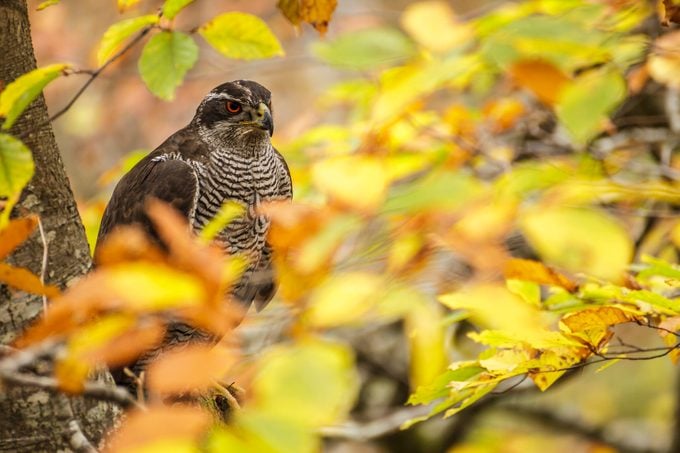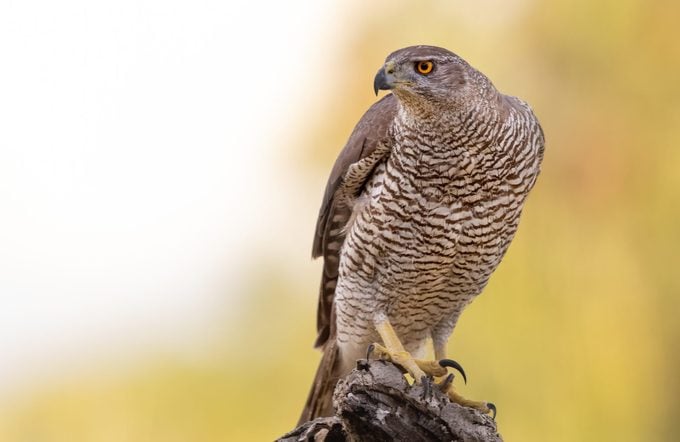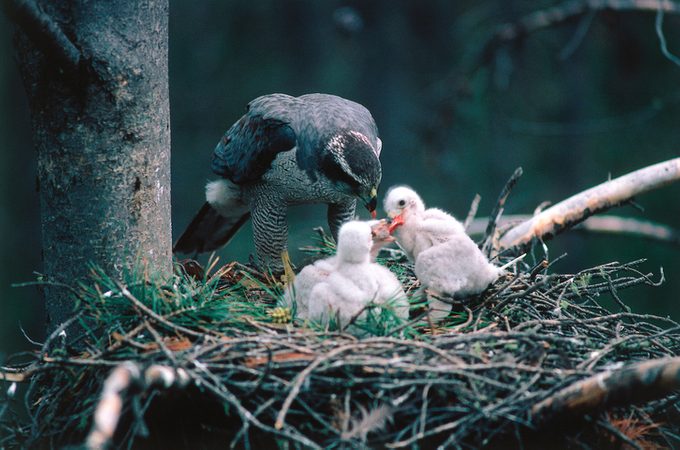The American Goshawk Has a New Name
Updated: Feb. 05, 2024
A majestic accipiter, the American goshawk (previously called the northern goshawk) rules from the forest trees. Learn how to spot one.
On This Page
American vs Northern Goshawk: Taxonomy Update

Birders might wonder where the name American goshawk came from—didn’t this bird used to be called the northern goshawk? The American goshawk name originated from a recent taxonomy update, splitting the northern goshawk title in two. Now, the American Ornithological Society views the northern goshawk as two separate species: the Eurasian goshawk and the American goshawk.
Meet more types of hawks you should know.
American Goshawk Identification

Larger than a crow, American goshawks are quickly identifiable by their size alone. From below, birders would look up at a white and gray striped breast and wings. When perched, the bird has gray wings and a gray back, with a pronounced white stripe above its red eyes. Birders can also note the bird’s yellow legs and sharp beak.
A juvenile features a white breast with brown streaks, a white and brown back, and a brown head with a white stripe above its yellow eyes. Adult females are larger than males.
Check out simply stunning pictures of hawks.
Range and Habitat
Permanent residents of much of Canada, the American goshawk primarily spends nonbreeding season in the United States. At that time, it can be found in much of the Midwest and Great Plains. These birds are permanent residents in portions of the West, including the Pacific coast.
Regardless of which section of their range you’re located in, you’re likely to find a goshawk in a forest. They prefer mature and old-growth forests, although they will hunt in open areas.
Here’s how to identify a red-tailed hawk.
Call and Sounds
Goshawks have a variety of screams and chirps, but they’ll give a high-pitched ki-ki-ki-ki-ki call when defending the nest or disturbed.
Bird songs courtesy of the Cornell Lab of Ornithology.
Diet
Like other birds of prey, goshawks eat small mammals and other birds. They’ll consume squirrels, jackrabbits, woodpeckers, and even larger birds such as crows. Their diet also includes reptiles and insects.
Falcon vs hawk: here’s how to tell the difference.
Nesting

These birds build their nests in large trees. The female constructs the nest, with the male providing some help; sometimes they reuse nests from previous years. A typical clutch size consists of two to four eggs. Parents incubate the eggs for about four weeks, and young remain in the nest for up to five more weeks.
Not sure which hawk you’re seeing? Consult these foolproof hawk identification tips.
Why Trust Us
For nearly 30 years, Birds & Blooms, a Trusted Media Brand, has been inspiring readers to have a lifelong love of birding, gardening and nature. We are the #1 bird and garden magazine in North America and a trusted online resource for over 15 million outdoor enthusiasts annually. Our library of thousands of informative articles and how-tos has been written by trusted journalists and fact-checked by bird and garden experts for accuracy. In addition to our staff of experienced gardeners and bird-watchers, we hire individuals who have years of education and hands-on experience with birding, bird feeding, gardening, butterflies, bugs and more. Learn more about Birds & Blooms, our field editor program, and our submission guidelines.




















